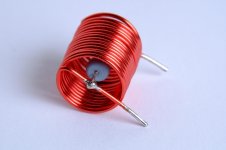I thought I'd post my method up here in case it's useful.
Playing with some class-D amp I thought it would be useful to make my own inductors, because they are only made of bits of wire and that's much cheaper than buying them right?
So I played with a bit of old toroid with 1.2mm wire until I realised that I needed a bobbin to hold it all together, or at least a former and some superglue.
Then I found a useful guide to them HERE.
gifs upload
So the bobbin's I chose are regular sewing bobbins, in plastic, mine measure 8.5mm dia in the middle and a length of 9mm for the coil.
I decided on AWG21 (0.72mm) wire giving a 0.05ohm DC resistance for a 10uH inductor needing 38 turns. Thicker wire will fit in but this is dead easy to manage and I only bought this one size. The design tool posted above gives you all the sizes if you want to try thicker wire - next time I'd probably go up one or two sizes, you'd also need less turns if you did.
After mounting the coil of wire (a 500g reel) in my solder dispenser I hand fixed an M6 bolt in the reel, set the drill on slow and 'backwards/undo' to wind the coil.
Using my finger and thumb to tension and guide the wire I just had to count to 38 and it was wound, and after about 5 minutes I had 4 nice inductors that actually measured exactly the same inductance as my 10uH Wurth ferrites I'd bought.
Note: Run the drill back as it self-tightens the bolt in the bobbin, go forward and it will just loosen off.
An additional advantage to winding your own is you can make the flyleads as long as you like, which makes soldering them in much easier and allows you to have less PCB track around gathering capacitance.
Probably best to mount them at right angles to each other as the flux is not so constrained like in a ferrite so you may get a little crosstalk. However you'll never saturate the cores and air is pretty linear so they should sound good.
Playing with some class-D amp I thought it would be useful to make my own inductors, because they are only made of bits of wire and that's much cheaper than buying them right?
So I played with a bit of old toroid with 1.2mm wire until I realised that I needed a bobbin to hold it all together, or at least a former and some superglue.
Then I found a useful guide to them HERE.
An externally hosted image should be here but it was not working when we last tested it.
gifs upload
So the bobbin's I chose are regular sewing bobbins, in plastic, mine measure 8.5mm dia in the middle and a length of 9mm for the coil.
I decided on AWG21 (0.72mm) wire giving a 0.05ohm DC resistance for a 10uH inductor needing 38 turns. Thicker wire will fit in but this is dead easy to manage and I only bought this one size. The design tool posted above gives you all the sizes if you want to try thicker wire - next time I'd probably go up one or two sizes, you'd also need less turns if you did.
After mounting the coil of wire (a 500g reel) in my solder dispenser I hand fixed an M6 bolt in the reel, set the drill on slow and 'backwards/undo' to wind the coil.
Using my finger and thumb to tension and guide the wire I just had to count to 38 and it was wound, and after about 5 minutes I had 4 nice inductors that actually measured exactly the same inductance as my 10uH Wurth ferrites I'd bought.
Note: Run the drill back as it self-tightens the bolt in the bobbin, go forward and it will just loosen off.
An additional advantage to winding your own is you can make the flyleads as long as you like, which makes soldering them in much easier and allows you to have less PCB track around gathering capacitance.
An externally hosted image should be here but it was not working when we last tested it.
An externally hosted image should be here but it was not working when we last tested it.
An externally hosted image should be here but it was not working when we last tested it.
An externally hosted image should be here but it was not working when we last tested it.
An externally hosted image should be here but it was not working when we last tested it.
Probably best to mount them at right angles to each other as the flux is not so constrained like in a ferrite so you may get a little crosstalk. However you'll never saturate the cores and air is pretty linear so they should sound good.

